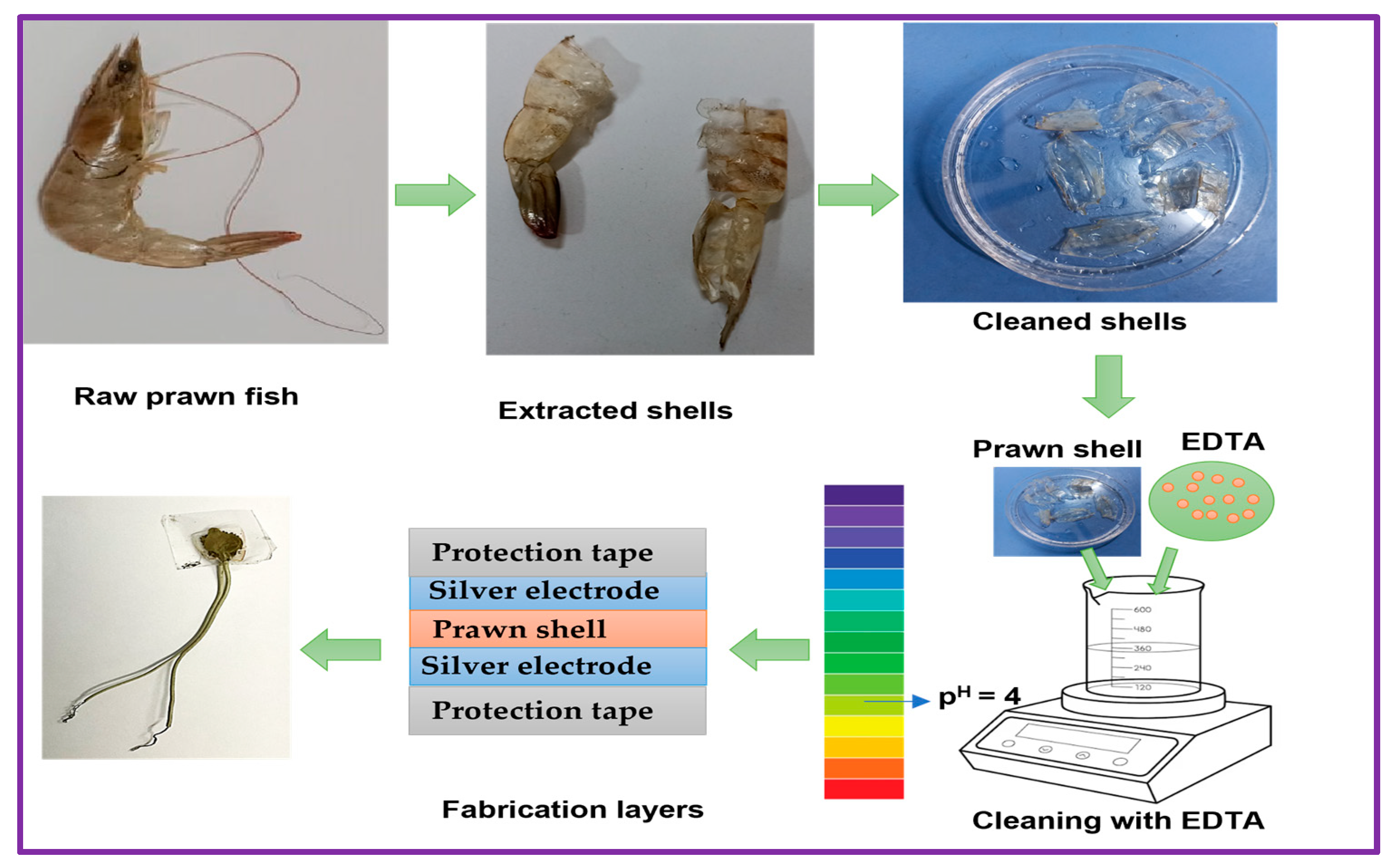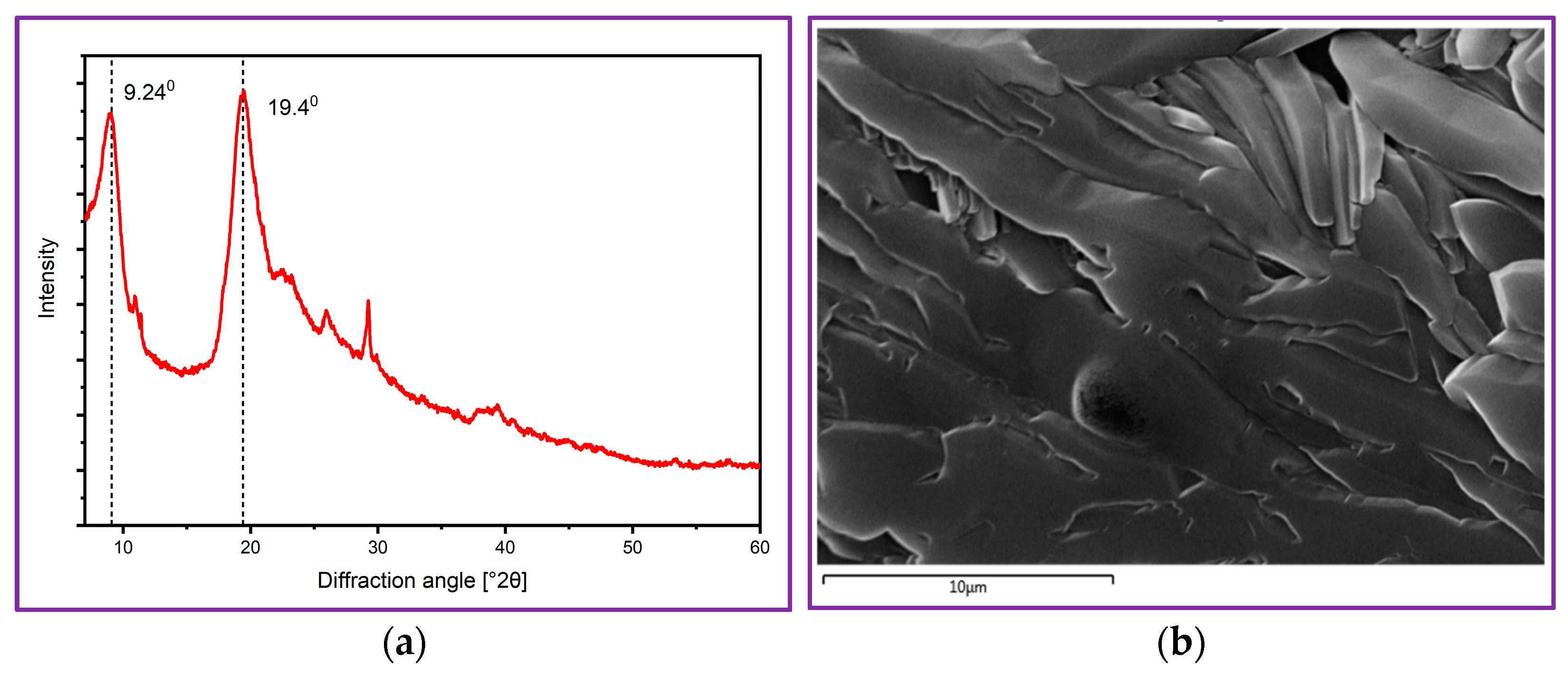Design and Development of a Fully Sustainable Piezoelectric Energy Harvester from Prawn Shell Biowaste †
Abstract
:1. Introduction
2. Materials and Methods
2.1. Sample Preparation and Device Fabrication
- The shells are collected from the biowaste of a local sea food processing plant;
- The shells are first cleaned with DI water to remove any loose debris or contaminants;
- The shells are cut into pieces and cleaned in an 8 M EDTA solution at room temperature using a magnetic stirrer at 700 rpm and pH 4. EDTA is a strong chelating agent that can effectively bind to metal ions and facilitate their removal from the shell’s surface;
- A small surface area of “10 mm × 8 mm” is used for the energy harvester fabrication;
- A conductive silver paste is used as the top and bottom electrodes and is deposited using the brush painting method. Moreover, two copper lead wire are connected for external electrical interfacing. The energy harvester fabrication process is shown in Figure 1.
2.2. Characterization
3. Results and Discussion
4. Conclusions
Author Contributions
Funding
Institutional Review Board Statement
Informed Consent Statement
Data Availability Statement
Acknowledgments
Conflicts of Interest
References
- Bairagi, S.; Ghosh, S.; Ali, S.W. A fully sustainable, self-poled, bio-waste based piezoelectric nanogenerator: Electricity generation from pomelo fruit membrane. Sci. Rep. 2020, 10, 12121. [Google Scholar] [CrossRef] [PubMed]
- Montazer, B.; Sarma, U. Design and optimization of quadrilateral shaped pvdf cantilever for efficient conversion of energy from ambient vibration. IEEE Sens. J. 2018, 18, 3977–3988. [Google Scholar] [CrossRef]
- Montazer, B.; Sarma, U. Modeling and Analysis the Effect of PZT Area on Square Shaped Substrate for Power Enhancement in MEMS Piezoelectric Energy Harvester. J. Circuits Syst. Comput. 2017, 26, 1750128. [Google Scholar] [CrossRef]
- Khatun, H.; Hazarika, S.; Sarma, U. Aluminium Plate Surface Defect Detection and CLassification based on Piezoelectric Transducers. In Proceedings of the 2021 IEEE 18th India Council International Conference, INDICON 2021, Guwahati, India, 19–21 December 2021. [Google Scholar]
- Ghosh, S.K.; Mandal, D.; Ghosh, S.K.; Mandal, D. High-performance bio-piezoelectric nanogenerator made with fish scale. Appl. Phys. Lett. 2016, 109, 103701. [Google Scholar] [CrossRef]
- Guerin, S.; Tofail, S.A.M.; Thompson, D. Organic piezoelectric materials: Milestones and potential. NPG Asia Mater. 2019, 11, 10. [Google Scholar] [CrossRef]
- Karan, S.K.; Maiti, S.; Paria, S.; Maitra, A.; Si, S.K.; Kim, J.K.; Khatua, B.B. A new insight towards eggshell membrane as high energy conversion efficient bio-piezoelectric energy harvester. Mater. Today Energy 2018, 9, 114–125. [Google Scholar] [CrossRef]
- Kumar, S.; Dipankar Mandal, G. Bio-assembled, piezoelectric prawn shell made self-powered wearable sensor for non-invasive physiological signal monitoring. Appl. Phys. Lett. 2017, 110, 123701. [Google Scholar]
- Marimuthu, R.; Ravichandran, S.; Suresh, A. Piezoelectric Property from Processed Prawn Shells. Chem. Sci. Rev. Lett. 2020, 9, 933–940. [Google Scholar]



Disclaimer/Publisher’s Note: The statements, opinions and data contained in all publications are solely those of the individual author(s) and contributor(s) and not of MDPI and/or the editor(s). MDPI and/or the editor(s) disclaim responsibility for any injury to people or property resulting from any ideas, methods, instructions or products referred to in the content. |
© 2023 by the authors. Licensee MDPI, Basel, Switzerland. This article is an open access article distributed under the terms and conditions of the Creative Commons Attribution (CC BY) license (https://creativecommons.org/licenses/by/4.0/).
Share and Cite
Khatun, H.; Kalita, R.; Goswami, M.P.; Sarma, U. Design and Development of a Fully Sustainable Piezoelectric Energy Harvester from Prawn Shell Biowaste. Eng. Proc. 2023, 56, 235. https://doi.org/10.3390/ASEC2023-15954
Khatun H, Kalita R, Goswami MP, Sarma U. Design and Development of a Fully Sustainable Piezoelectric Energy Harvester from Prawn Shell Biowaste. Engineering Proceedings. 2023; 56(1):235. https://doi.org/10.3390/ASEC2023-15954
Chicago/Turabian StyleKhatun, Hiramoni, Rima Kalita, Manash Pratim Goswami, and Utpal Sarma. 2023. "Design and Development of a Fully Sustainable Piezoelectric Energy Harvester from Prawn Shell Biowaste" Engineering Proceedings 56, no. 1: 235. https://doi.org/10.3390/ASEC2023-15954




